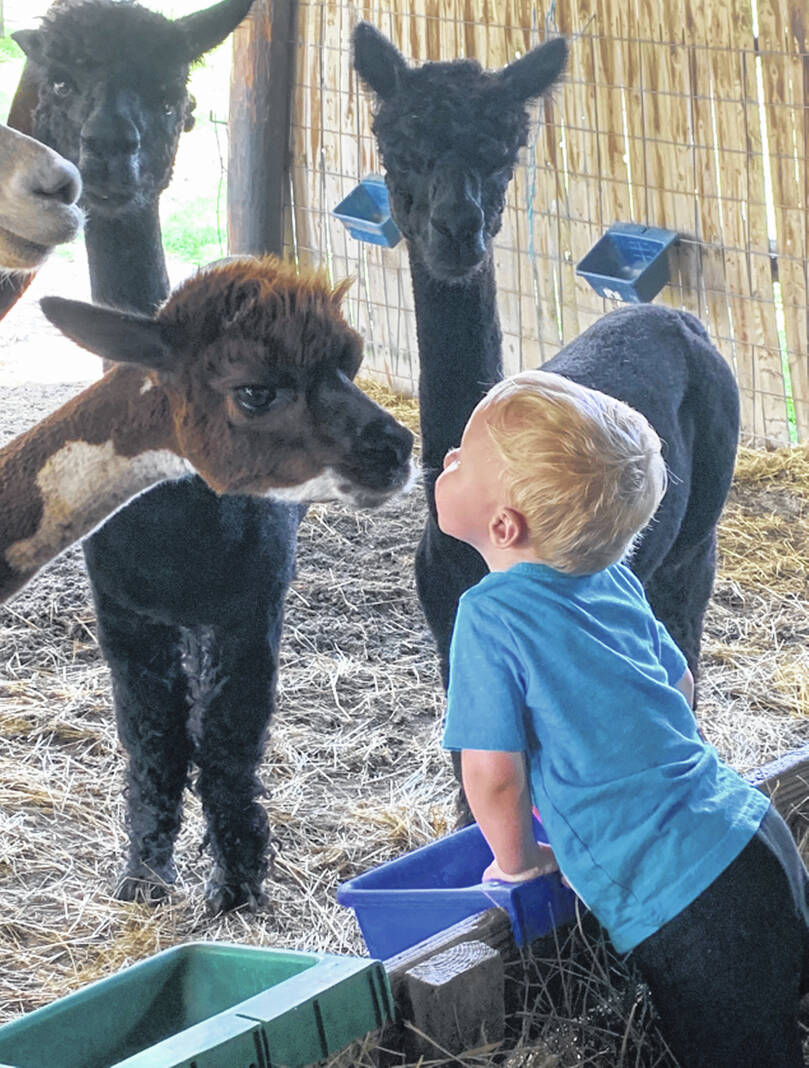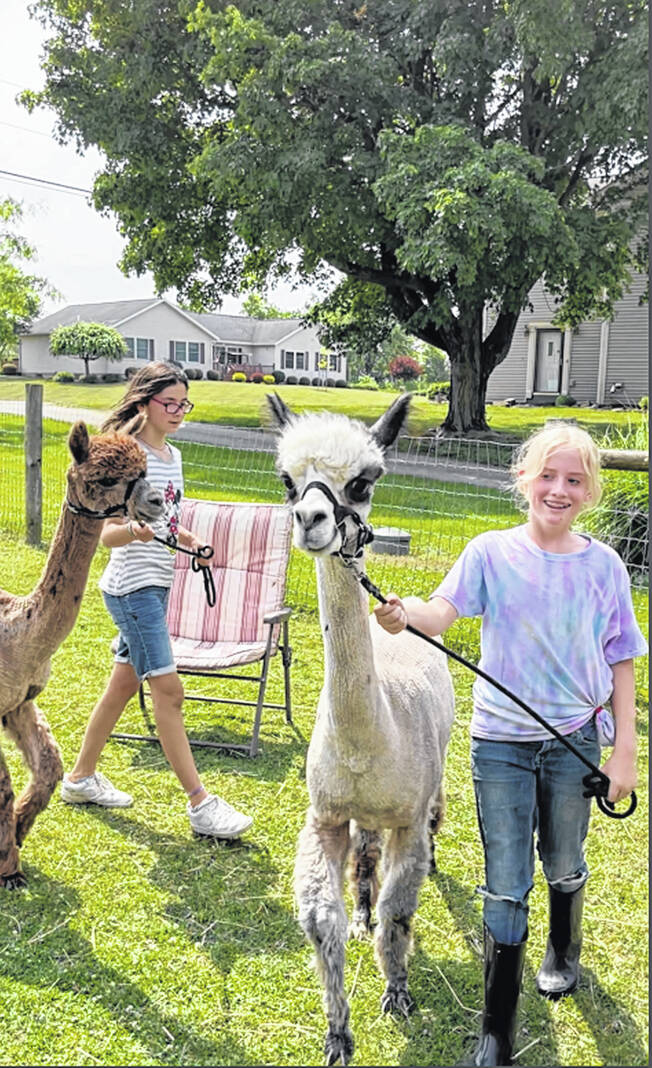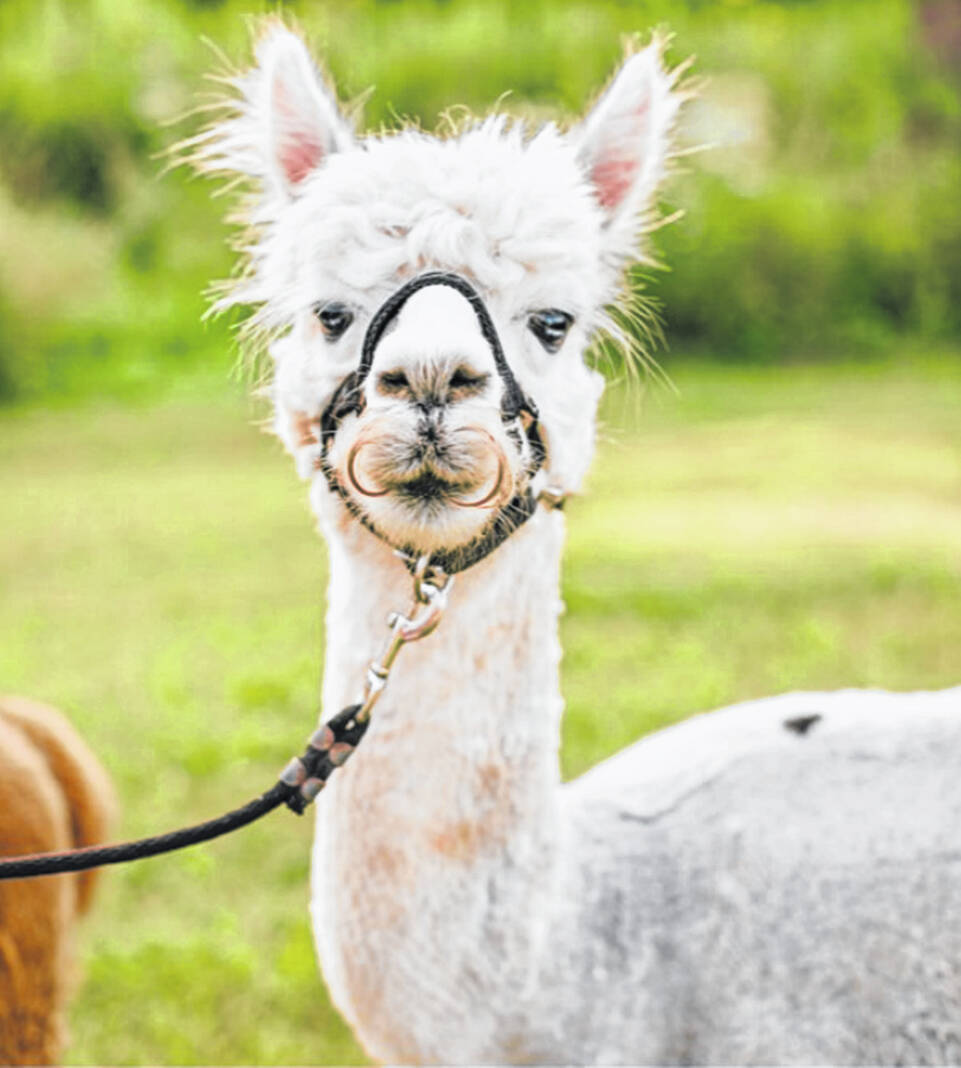
Brody Paulus enjoying some up-close and personal time with alpaca Cinderella. Brody is the son of Joshua and Heather Paulus.
Courtesy photo

Sadie and Abby Billenstein helping with the alpaca obstacle course at the farm. They are the daughters of Doug and Janet Billenstein.
Courtesy photo

Stormy, a herdsire, the alpaca with a mustache.
Courtesy photo
SIDNEY — On Sept. 23 from 11 a.m. to 4 p.m., Rick and Annette Paulus will invite guests to Count Your Blessings Alpacas, located at 680 Doorley Road, Sidney, to meet their alpacas and learn more about these inquisitive, unique animals and the luxury fiber they produce.
This will be the 15th year of this free event. There will be many activities, including petting, feeding and leading alpacas, demonstrations, alpaca obstacle course, door prizes, and a hayride. Enjoy food and refreshments and listen to the music by Timmy G. & Co. and the hum of the alpacas. This is also an opportunity to learn what is so special about alpaca fiber and the variety of wonderful products that people enjoy. Alpaca products will be on display and available for purchase if interested.
About Alpacas
Alpacas are cousins to the llama and are beautiful, intelligent animals, native to the Andean Mountain range of South America, particularly Peru, Bolivia, and Chile. Alpacas are considerably smaller than llamas, and unlike llamas, they were not bred to be beasts of burden or guard animals but were bred specifically for their fiber, which is used for making knitted and woven items, similar to wool.
Adult alpacas stand at approximately 36 inches at the withers and generally weigh between 150 and 200 pounds. They do not have horns, hooves, claws, or incisors. Alpacas are alert, intelligent, curious, and predictable. They are social animals that seek companionship and communicate most commonly by softly humming.
About Alpaca Fiber
Long ago, alpaca fiber was reserved for royalty. Today, it is sold several ways. Hand-spinners and fiber artists buy raw fleece. Knitters often purchase alpaca yarn. Fiber cooperatives mills collect alpaca fiber and process it on behalf of the producer.
Alpacas are shorn, without harm, every year, generally in the spring before the hot summer months. An adult alpaca might produce 5 to 8 lbs of fiber.
Because of its soft texture, alpaca fiber is sometimes compared to cashmere. The fiber also has the luster of silk, making it even more coveted. Alpaca is just as warm as wool, yet it is a mere 1/3 the weight. It comes in 16 natural colors and can be dyed any desired shade.
Containing no lanolin, alpaca fiber is also naturally hypoallergenic. Most people who are sensitive to wool find that they can wear alpaca without the itching or irritation they feel from wool because alpaca fiber has a smaller diameter therefore feeling smooth to the skin. Additional performance characteristics include stretch, water repellency, and odor reduction. For travelers, clothing made from alpaca is desirable because it is wrinkle-resistant.
Today’s consumer searches for high-quality, environmentally sound products made of naturally renewable resources. The alpaca provides fiber, just as it has for thousands of years, to create colorful garments that are soft to the touch. Classically styled alpaca sweaters and suits can last for generations.
Socks, scarves, purses, golf shirts, teddy bears, and blankets are just a few additional items made from North American alpaca fiber currently on the market.
Green Alpacas?
Alpacas come in 16 natural colors, but they are all green!
Sensitive to their environment in every respect, alpacas have soft padded feet instead of hooves and can leave even the most delicate terrain undamaged.
Alpacas prefer to eat tender grasses, which they do not pull up by the roots. Lacking upper teeth, alpacas “cut” the grass with their bottom teeth and upper palate. This vegetation cutting encourages the plants’ growth. Because they are modified ruminants with a three-compartment stomach, alpacas convert grass and hay to energy very efficiently and stop eating when they are full, further preserving the landscape on which they live.
Alpacas’ pellet-like droppings are PH balanced, and an excellent, natural, slow-release, low odor fertilizer. This rich fertilizer is perfect for growing fruits and vegetables. Because alpacas consolidate their feces in one or two communal spots in the pasture, it is easy to collect and compost, and the spread of parasites is controlled.
While alpacas are environmentally friendly — and even beneficial — to the land, what makes them even more “green” is the fiber they produce. No chemicals are employed either during feeding or during the industrial production of alpaca fleece into fiber. If dying is desired, only 20% of a normal dye quantity is required.
All fiber from an alpaca can be used. Even the fiber from the lower legs, belly, neck, etc. is being used for things such as natural weed mats to be placed around trees and in gardens. Alpaca fiber is biodegradable.
Fun Facts
All alpacas are capable of spitting, but it is almost always reserved for other alpacas, not humans.
Alpacas are very vocal and make many sounds to communicate their feelings. The most common is a humming sound to let the others know that they are present and calm.
To learn more about Count Your Blessings Alpacas, call 937-538-0308, find “Count Your Blessings Farm” on Facebook or go to www.cybalpacafarm.com.

